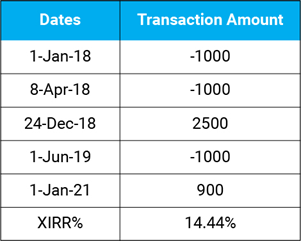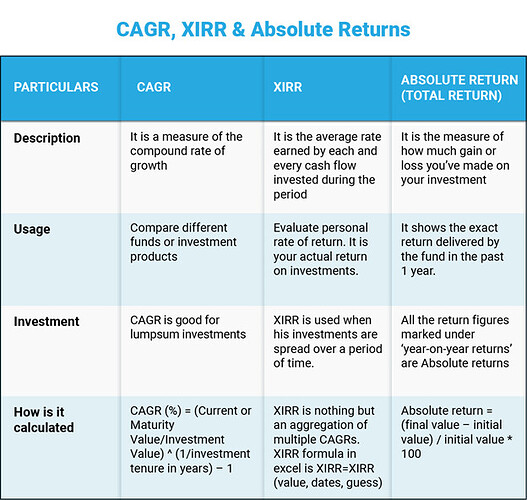All mutual fund returns, be it CAGR, XIRR etc. you see are the historical returns of the fund, which gives you an idea about their performance for the period you’ve selected. Through this article, we tell you about different types of mutual fund returns, and see what each of them means, and also analyze in what ways are they different from each other.
WHAT ARE ABSOLUTE RETURNS?
Absolute Returns or Total Returns is simply how much gain or loss you’ve made on your investment. It is the simplest measure of calculating returns.
When is Absolute Returns used
Simple point-to-point return (absolute returns) is preferred when the holding period is less than one year
How to calculate Absolute Returns
At the end of Year 2019, Sunil’s investment value was Rs. 1,00,000. And after ten months, his investment matures to Rs. 1,20,000. His absolute returns will be:
Absolute Returns = (Final Value – Initial Value) / Initial Value * 100
= (1,20,000-1,00,000/1,00,000)*100 = 20%
WHAT IS COMPOUNDED ANNUAL GROWTH RATE (CAGR)?
CAGR or Compound Annual Growth Rate gives you the investments annual growth rate over some period of time. You may use CAGR to determine the exact percentage of the returns from your investments each year, across the investment tenure.
When to use CAGR?
When you compare different funds or investment products, you must compare the CAGR to arrive at a more accurate earning potential. CAGR takes into consideration the investment tenure and thus provides a more accurate and comparable earnings percentage. You may use CAGR to compare the historical returns of bonds, stocks or mutual funds. It helps you gauge the returns from your investments over the entire investment tenure.
How to calculate CAGR?
The formula to calculate CAGR is:
CAGR (%) = (Ending investment value/Beginning Investment Value) ^ (1/investment tenure in years) – 1

The table above is for illustration purposes only.
Having compared both the options, you can see that scheme B is earning better returns than Scheme A. While the absolute returns on the Scheme A is higher than the second one, however, the earning potential for the second option is greater as determined by the CAGR.
WHAT IS EXTENDED INTERNAL RATE OF RETURN (XIRR)?
XIRR stands for Extended Internal Rate of Return is a method used to calculate returns on investments. XIRR is that single rate of return, which when applied to every installment (and redemptions if any) would give the current value of the total investment. XIRR is your personal rate of return. It is your actual return on investments.
When to use XIRR?
Although CAGR is one of the widely used and popular measures of calculating mutual fund returns, one of the limitations it has is that it does not take periodic investments into account. XIRR is a good function to calculate returns when your cash flows (investments or redemption) is spread over a period of time. So when there is a one-time lump sum investment, CAGR is an apt measure, but not in the case of measuring SIP returns. XIRR is a better way to calculate returns when there is a series of investments being made over time, including transactions such as withdrawals, dividends, switch, etc.
How to calculate XIRR
You can think of XIRR as nothing but an aggregation of multiple CAGRs. If you make multiple investments in a fund, you can use the XIRR formula to calculate your overall CAGR for all those investments taken together.
In real life the investments & redemptions happen over different period of time and CAGR won’t be applicable to calculate the returns.
To understand this better, let’s take this illustrative example. All purchases or investments are denoted by negative values and all redemptions are denoted by positive values. As on Jan 01, his investments come to Rs.900. XIRR in this case becomes 14.44%.

At the end of the day, we select mutual funds to grow our money and earn better returns. You can use these returns to evaluate how your mutual fund investment is performing among parity schemes and with other avenues such as bank deposits.
- While choosing an equity fund, don’t judge the fund’s performance by seeing its absolute or 1-year return, evaluate it on the basis of its CAGR or XIRR i.e returns of more than a year (3/5/7/10 year returns).
- XIRR works much better for calculating returns from your mutual fund as compared to CAGR.( (when there is periodic investment)
Disclaimer: The views expressed here in this Article / Video are for general information and reading purpose only and do not constitute any guidelines and recommendations on any course of action to be followed by the reader. Quantum AMC / Quantum Mutual Fund is not guaranteeing / offering / communicating any indicative yield on investments made in the scheme(s). The views are not meant to serve as a professional guide / investment advice / intended to be an offer or solicitation for the purchase or sale of any financial product or instrument or mutual fund units for the reader. The Article / Video has been prepared on the basis of publicly available information, internally developed data and other sources believed to be reliable. Whilst no action has been solicited based upon the information provided herein, due care has been taken to ensure that the facts are accurate and views given are fair and reasonable as on date. Readers of the Article / Video should rely on information/data arising out of their own investigations and advised to seek independent professional advice and arrive at an informed decision before making any investments. None of the Quantum Advisors, Quantum AMC, Quantum Trustee or Quantum Mutual Fund, their Affiliates or Representative shall be liable for any direct, indirect, special, incidental, consequential, punitive or exemplary losses or damages including lost profits arising in any way on account of any action taken basis the data / information / views provided in the Article / video.
Mutual Fund investments are subject to market risks, read all scheme related documents carefully.
